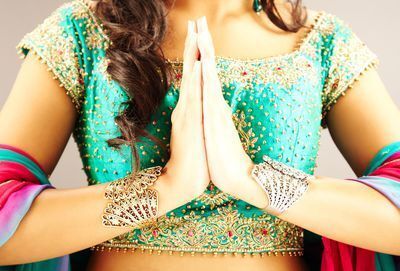Añjali Mudrā

It seems simple enough, this prayer hands mudrā we call Añjali Mudrā. But there is more to it than meets the eye. It is a gesture that is common in the iconography of Indian spirituality and religion, whether in Buddhism, Hinduism or Jainism.
Do not press the palms together
The word añjali references the little cavity that is created in the space between the palms of the hands when the mudrā is properly performed. Añjali means "divine offering" and that little space in the palms of the hands is like a treasure box containing the sweetest of offerings.
So properly performed, the outer rim of the hands and the fingers are joined, and a little space is kept in the palms, which contains your dedication. The thumbs are held so their inside surface faces in, and their backs are out.
Heart, chin, forehead or above the head?
Tradition would have the gesture made at or above head level when greeting the divine (as in temple), at the chin or mouth level for greeting someone revered, and at heart level for greeting peers.
In various rituals and indeed, yoga postures, the gesture may be made at different levels.
Effect of Añjali Mudrā
When we make añjali mudrā we might notice a centering effect, and a tendency to become reverential and quiet. It assists us in focussing and coming into a meditative state.
Author: Tina Shettigara